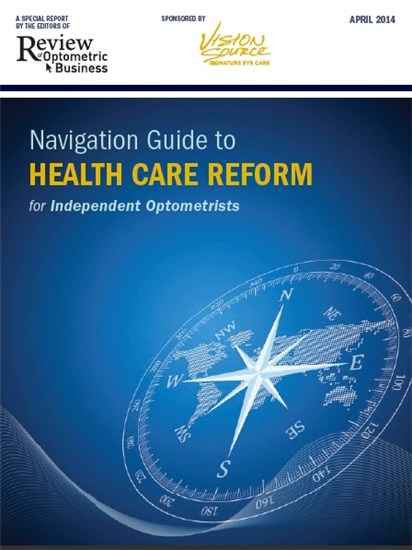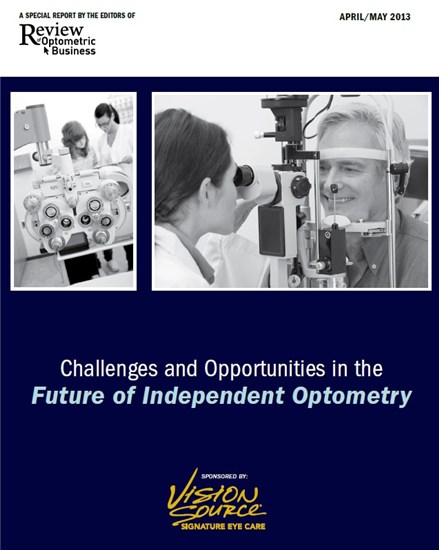By ROB Editors
Vision Source commissioned Review of Optometric Business to create the “Navigation Guide to Health Care Reform for Independent Optometrists,” a report summarizing important trends in US health care delivery and what they mean for independent optometrists. Included in the report are strategy imperatives and action plans. This is the third article in a three-part series.
 CLICK HERE or on the image to the left to download the full report, published in April 2014.
CLICK HERE or on the image to the left to download the full report, published in April 2014.
In order to capture growth opportunities in this era of health care reform, optometrists must realign office processes to capture efficiencies that will allow them to deliver expanded services.
Increased patient visits
The number of patient visits to OD offices in the years ahead will increase, due to rapid growth of the senior population, greater access to care by previously uninsured patients and greater OD involvement in extending primary care monitoring of chronic disease. The largest increases in patient counts are likely to be in Medicare and Medicaid populations and in youth using the new pediatric benefit. Higher patient counts will increase the need to serve patients efficiently, with no reduction in personalization of care.
Reimbursement squeeze
As third-party payers account for a growing share of health care spending, it is inevitable that they exert an increasing influence on fee reimbursements, treatment options, claims filing procedures and outcomes reporting requirements.
In an environment with increased emphasis on cost containment, independent ODs can expect that fee reimbursement amounts paid by third-parties will lag behind the overall inflation rate, putting pressure on
net income. Third-party payers are also likely to limit allowances for eyewear and contact lenses, covering only the most basic requirements and not keeping pace with the steady rise in the average cost of corrective devices, caused by new technologies.
An increasing number of patient visits per OD hour, coupled with stagnant reimbursement rates, will increase the importance of maximizing the amount of patient care delivered per OD hour. Over time, OD reimbursement by third-parties are likely to be based less on compensation for individual services rendered and more on measures of outcomes for large populations, patient satisfaction ratings and other measures of quality of care.
Spread of coordinated care model
Government, insurers and large employers will increasingly support the coordinated care model of health care delivery, by which a local population is cost-effectively provided comprehensive care through a team of providers. For ODs, the new delivery model has the potential to expand access to patients, but at rigorously controlled levels of compensation. Coordinated care places new burdens on ODs to rapidly and succinctly communicate with other network providers.
Action Plan
Refine office processes to optimize revenue from managed care patients.
Professional fees from routine eye exams are likely to be a shrinking revenue source in the years ahead, as third-party payers limit reimbursements. Practice profitability will increasingly depend on expanding medical eyecare services and increasing sales of high technology vision correction devices. Most third-party payers limit reimbursement on eyewear and contact lenses to cover only the most basic types. It will become increasingly important that ODs position managed care allowances to patients as important contributions to eyecare costs, not as full payment for the high performance products that patients expect. Effective patient
education about managed care benefits will become more critical to the financial health of the practice.
Each practice needs a scripted process to handle patients who state they only want what their plan covers. The scripts must help patients understand the value of multiple pairs of glasses, back-up eyewear with contact lenses, sunglasses with contact lenses, glare-free lenses with cataracts, glare-free lenses with dry eye syndrome, blue-blocking lenses with macular degeneration and other advanced technology products.
Improve patient care efficiency.
As the number of patient visits grows, ODs must pay greater attention to maximizing the value delivered for each minute the office spends in patient care. That will mean increased delegation of testing and administrative duties to staff and reconfiguring office processes to maximize patient flow. Each practice should evaluate the current efficiency of its office systems.
Questions that can reveal current efficiency include:
• Do you run behind constantly?
• Do you have a lot of patient down-time in the office?
• Does the practice need to reschedule patients because the office wasn’t ready to deliver care today?
Whatever problems are discovered should be immediately addressed.
Develop medical eyecare protocols for common conditions.
Click HERE to access the AOA medical eyecare protocols and implement them
Upgrade co-management communications.
In the new world of integrated health care, quality of care will increasingly depend on thorough and clear communication of clinical findings, diagnoses and treatment plans within provider networks. ODs will need to communicate efficiently and effectively with general practitioners and specialists on most patients seen, so that all physicians involved in caring for the same patient are fully informed of ODs’ evaluations and management. ODs need to consider the outcomes of the specialists to whom they refer patients. The result will be greater recognition by physicians of the value of patient care delivered by ODs.
Train staff to educate managed care patients.
As new health organizations emerge, and as ODs affiliate with them, new rules and requirements will appear, making the tasks of patient education and administration more complex. This will place new demands on staff to understand and comply with the new ground rules of third-party payers.
Be prepared for a family of three to come into the office with Mom having coverage from her employer, Dad having been thrown into one of the plans on the Marketplace, and the 12-year-old child having coverage from a completely different third party. Your staff must be prepared to explain the differences in deductibles and coverage that occurs among the plans.
The staff must be prepared to deal with patients having higher out-of-pocket expenses than in the past. There must be a system in place to calculate immediately (that is, while the patient is in front of staff) what the patient owes. It is also helpful to have systems in place to help patients pay for out-of-pocket expenses, beyond typical credit cards. These include options such as PayPal and CareCredit.
Upgrade medical record keeping skills.
To achieve this goal, implement the Office of Inspector General (OIG’s) Compliance Program for Individual and Small Group Physician Practices.
Click HERE for details
Improve recall processes.
Effective management of diabetic and glaucoma patients and other patient with chronic conditions will require rigorous recall methodologies. This will assure that insurer that HEDIS scores are maximized.
To the extent that an OD’s patients are examined on an annual basis through recall activity, ODs will be more effective gatekeepers of patients’ overall health and will be more effective at helping third-party payers control costs and improve outcomes.
RELATED ARTICLES
Major Implications of Health Care Reform–For Independent ODs
 RELATED REPORT
RELATED REPORT
Challenges and Opportunities in the Future of Independent Optometry



























